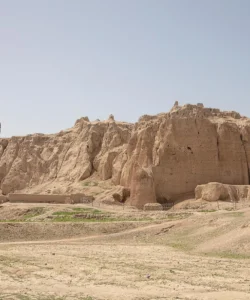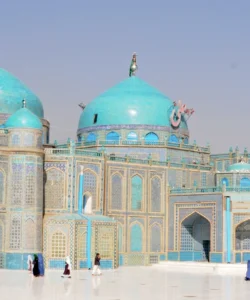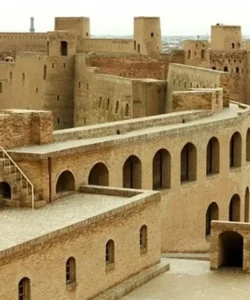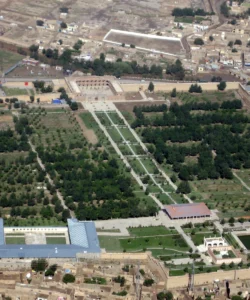Band-e Amir National Park is a spectacular and little-known natural wonder located in the central highlands of Afghanistan. It holds immense significance as the country’s first national park and is globally renowned for its series of intensely blue lakes separated by natural travertine dams.
Name: Band-e Amir National Park (Dari: پارک ملی بند امیر; Pashto: د امیر بند ملي پارک)
Address: The park is situated in the central Bamyan Province of Afghanistan, high in the Hindu Kush mountain range. It lies approximately 75 kilometers (47 miles) northwest of the ancient city of Bamiyan, a region historically known for the destroyed colossal Buddhas.
How to Get There:
Travel to Band-e Amir is extremely difficult and dangerous due to the political instability in Afghanistan. The following information is for historical context and is not a recommendation for travel.
- By Air: The closest airport to the park is in Bamiyan. International visitors would typically fly into Kabul International Airport (KBL) and then take a domestic flight to Bamiyan, though internal flights can be sporadic.
- By Road: From Bamiyan town, Band-e Amir is about a 2-5 hour drive on a rough, often unpaved road. A 4×4 vehicle is recommended. The drive itself offers stunning mountain views.
- Permits: Prior to recent events, permits were required from the government in Kabul and again in Bamiyan.
- Best Time to Visit: The lakes are a popular destination in late spring and summer, from May to October, when the weather is warmer and the lakes are not frozen.
Landscape and Architecture:
Band-e Amir’s “architecture” is a rare geological marvel, where natural forces have sculpted a breathtaking landscape of lakes and dams. There is minimal human-built architecture within the core of the park.
- Travertine Dams and Lakes: The park’s defining feature is a chain of six intensely blue lakes, which are among the few travertine systems in the world. These lakes were formed over millennia by mineral-rich water seeping from faults in the rock. The water deposited layers of hardened mineral (travertine), which gradually built up into stunning, natural walls or dams.
- Varying Blue and Turquoise Hues: The lakes are famous for their intense and vibrant colors, ranging from faint turquoise to a deep sapphire blue. This is a result of the high mineral content in the water and the way light reflects off the travertine beds.
- Six Constituent Lakes: The park consists of six main lakes, each with its own unique character, and some with names tied to local folklore:
- Band-e Haibat (Lake of Grandiose): The largest and deepest lake, its still waters offer perfect reflections of the surrounding cliffs.
- Band-e Panir (Lake of Cheese): Named for its whitish mineral deposits along its shores.
- Band-e Zulfiqar (Lake of the Sword of Ali): A long, narrow lake.
- Band-e Pudina (Lake of Wild Mint).
- Band-e Qambar (Lake of Caliph Ali’s slave).
- Band-e Gholaman (Lake of the Slaves).
- Stark, Rugged Cliffs: The lakes are nestled amidst imposing limestone cliffs, largely devoid of vegetation, creating a landscape of stark contrasts between the arid, rugged terrain and the vibrant blue waters.
- Local Folklore and Legend: Local legend attributes the formation of the natural dams to a miracle performed by Ali, the fourth Caliph of Islam. A small, mosque-like tomb dedicated to him overlooks Band-e Haibat, adding a layer of religious significance.
- Minimal Tourist Infrastructure: Within the park, there are minimal facilities. A park office and some basic amenities were installed after its establishment as a national park. The local people rely on the park’s natural resources for their livelihood.
What Makes It Famous:
- Afghanistan’s First National Park: Established in 2009, Band-e Amir holds the distinction of being Afghanistan’s inaugural national park, a significant milestone for conservation in the country.
- Travertine Lake System: It is globally renowned for being one of the few places in the world with a travertine lake system, a rare geological phenomenon where natural mineral deposits form dams, creating a series of cascading lakes.
- Intensely Blue Lakes: The park’s most famous feature is the stunning, almost surreal, vibrant blue and turquoise hues of its six lakes, a visual spectacle that has earned it comparisons to Afghanistan’s “Grand Canyon.”
- Pilgrimage Site and Local Legend: The lakes are steeped in local folklore and religious significance, believed to have been created by a miracle of Caliph Ali, and they serve as a pilgrimage destination for local people.
- Biodiversity: Despite the rugged landscape, the park is home to a variety of wildlife, including ibex, urials (wild sheep), wolves, and foxes, and is a designated Important Bird Area.
- Tentative UNESCO World Heritage Site: Band-e Amir has been submitted for recognition as a UNESCO World Heritage Site, which would further protect its unique geological and natural beauty.
Differences from Some Other Wonders:
- Travertine Lake Formation: While other wonders feature unique lakes (e.g., Kelimutu’s volcanic lakes, Lonar Lake’s meteorite crater), Band-e Amir is defined by its travertine dams, a very specific and rare geological process of mineral deposition that created its lakes.
- Stark Contrast of Arid Cliffs and Vibrant Water: Its landscape presents a striking contrast between the desolate, rugged, limestone cliffs of the Hindu Kush and the intensely blue lakes, a visual that is unique.
- Historical and Political Context: The park’s history is intertwined with decades of war and political strife that delayed its establishment, making its creation in 2009 a story of resilience and a source of hope for the country’s natural heritage.
- Primarily a Domestic Tourist Destination: Due to ongoing security concerns, Band-e Amir has been a significant domestic tourism destination for Afghans, but has seen very little international tourism in recent decades, making its primary visitor base different from most other wonders.
- Blend of Natural and Religious Wonders: Similar to Mount Popa or sites like the Archaeological Remains of the Bamiyan Valley, it’s a place where a profound natural phenomenon is deeply embedded in local religious belief and folklore, adding a layer of spiritual mystique.
- Lack of Developed Infrastructure: The park has very little in the way of modern tourist facilities or infrastructure, emphasizing its raw, untouched, and remote wilderness character, which is part of its charm but also a reflection of the challenges of its location.
Band-e Amir National Park Photos:













































